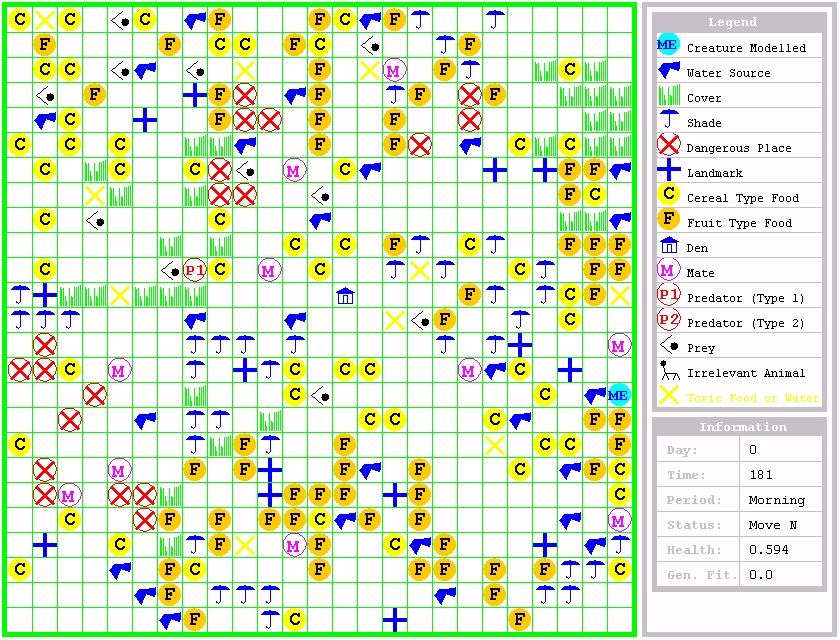| The World-Wide-Mind server: | The Tyrrell world: |
The "Tyrrell's world" World server is online at w2mind.computing.dcu.ie

perceivedFatShortage:0.5994355682777777;
perceivedCarbohydrateShortage:0.6003002752721399;
perceivedProteinShortage:0.5970390398266352;
perceivedWaterShortage:0.6010274482908156;
perceivedAnimalLowTemperature:0.0;
perceivedAnimalHighTemperature:0.0;
perceivedCellLowTemperature:0.0038469630420412924;
perceivedCellHighTemperature:0.0; mateCourted:0.0;
perceivedAnimalCleanliness:0.5021354162694708;
nightProximity:0.002006389150289807; animalVariance:0.0;
distanceFromDen:0.0;
foodPerceptionStimulus:[0.0,0.1,0.1,0.0,0.1,0.1,0.1,0.1,0.1];
foodMemoryStimulus:[0.0,0.0,0.0,0.0,0.0,0.0,0.0,0.0,0.0];
waterPerceptionStimulus:[0.0,0.0,0.0,0.0,0.0,0.0,0.0,0.0,0.0];
waterMemoryStimulus:[0.0,0.0,0.0,0.0,0.0,0.0,0.0,0.0,0.0];
shelterPerceptionStimulus:[1.0,0.0,0.0,0.0,0.0,0.0,0.0,0.0,0.0];
shadePerceptionStimulus:[0.7,0.0,0.0,0.0,0.0,0.0,0.0,0.0,0.0];
predator1PerceptionStimulus:[0.0,0.0,0.0,0.0,0.0,0.0,0.0,0.0,0.0];
predator2PerceptionStimulus:[0.0,0.0,0.0,0.0,0.0,0.0,0.0,0.0,0.0];
dangerousPlacePerceptionStimulus1:[0.0,0.0,0.0,0.0,0.0,0.0,0.0,0.0,0.0];
irrelevantAnimalPerceptionStimulus1:[0.0,0.0,0.0,0.0,0.0,0.0,0.0,0.0,0.0];
matePerceptionStimulus:[0.0,0.0,0.0,0.0,0.0,0.0,0.0,0.0,0.0];
denPerceptionStimulus:[1.0,0.0,0.0,0.0,0.0,0.0,0.0,0.0,0.0];
denMemoryStimulus:[1.0,0.0,0.0,0.0,0.0,0.0,0.0,0.0,0.0];
timeSinceLastScan:0.0; distanceToCover:0.0;
timeSinceLastPredator:1.0; animalHealth:1.0;
animalPermanentInjury:0.0;
dangerousPlacePerceptionStimulus2:[0.0,0.0,0.0,0.0,0.0,0.0,0.0,0.0,0.0];
irrelevantAnimalPerceptionStimulus2:[0.0,0.0,0.0,0.0,0.0,0.0,0.0,0.0,0.0];
|
When we "run" the Mind in the World, we repeatedly ask the World to describe itself by sending it a "Get State" message, then we ask the Mind what to do by sending it a "Get Action" message, then we execute the action by sending the World server a "Take Action" message.
You can:
if (predator visible) ask Mind73 what to do if answer=n ignore it and override with my own action else do whatever Mind73 suggests else (no predator visible) don't ask any other Mind, take my own action
Notes:
All I ask is that your write-up is honest and explains what you did. I will decide the exact score at the end:
It may be used for further experiments in our WWM research project, which aims to find ways of building up complex Minds composed of the works of multiple authors. Previous students' Minds have ended up being re-used in larger, multi-Mind systems, and even discussed in various scientific papers.
e.g. See a paper:
![]() at the
8th International Conference on the Simulation of Adaptive Behavior
in Los Angeles in 2004.
at the
8th International Conference on the Simulation of Adaptive Behavior
in Los Angeles in 2004.
If you do not want this to happen, you can delete your Mind at any time. (But wait until after you have got your practical results!)